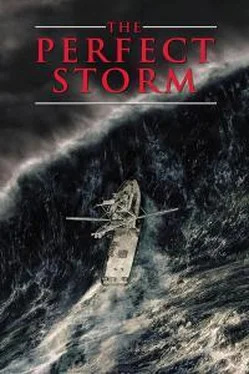Sebastian Junger - The Perfect Storm
Здесь есть возможность читать онлайн «Sebastian Junger - The Perfect Storm» — ознакомительный отрывок электронной книги совершенно бесплатно, а после прочтения отрывка купить полную версию. В некоторых случаях можно слушать аудио, скачать через торрент в формате fb2 и присутствует краткое содержание. Жанр: Триллер, Проза. Описание произведения, (предисловие) а так же отзывы посетителей доступны на портале библиотеки ЛибКат.
- Название:The Perfect Storm
- Автор:
- Жанр:
- Год:неизвестен
- ISBN:нет данных
- Рейтинг книги:3 / 5. Голосов: 1
-
Избранное:Добавить в избранное
- Отзывы:
-
Ваша оценка:
- 60
- 1
- 2
- 3
- 4
- 5
The Perfect Storm: краткое содержание, описание и аннотация
Предлагаем к чтению аннотацию, описание, краткое содержание или предисловие (зависит от того, что написал сам автор книги «The Perfect Storm»). Если вы не нашли необходимую информацию о книге — напишите в комментариях, мы постараемся отыскать её.
The Perfect Storm — читать онлайн ознакомительный отрывок
Ниже представлен текст книги, разбитый по страницам. Система сохранения места последней прочитанной страницы, позволяет с удобством читать онлайн бесплатно книгу «The Perfect Storm», без необходимости каждый раз заново искать на чём Вы остановились. Поставьте закладку, и сможете в любой момент перейти на страницу, на которой закончили чтение.
Интервал:
Закладка:
The mechanics of a hurricane are fundamentally the same as a cutoff low, but their origins differ: hurricanes brew in the lukewarm waters around the equator. When the sun hits the equator it hits it dead-on, a square-foot beam of light heating up exactly one square foot of water. The farther north or south you are, the lower the angle of the sun and the more water a square foot of sunlight must heat up; as a result the water doesn't heat up as much. The equatorial sea cooks all summer and evaporates huge amounts of water into the air. Evaporated water is unstable and contains energy in the same way that a boulder on top of a hill does—one small push unleashes a huge destructive force. Likewise, a drop in air temperature causes water vapor to precipitate out as rain and release its latent energy back into the atmosphere. The air above one square foot of equatorial water contains enough latent energy to drive a car two miles. A single thunderstorm could supply four days' worth of the electrical power needed by the United States.
Warm air is less dense than cool air; it rises off the surface of the ocean, cools in the upper atmosphere, and then dumps its moisture before rushing back to earth. Huge cumulus clouds develop over the zones of rising air, with thunder, lightning, and terrifically strong rain. As long as there's a supply of warm water, the thunderstorm sustains itself, converting moisture into sheeting rain and downdraft winds. Other thunderclouds might line up along the leading edge of a cold front into a "squall line," a towering convective engine that stretches from horizon to horizon.
Hurricanes start when a slight kink—a disturbance in the trade winds, a dust storm blowing out to sea off the Sahara— develops in the upper-level air. The squall line starts to rotate around the kink, drawing in warm, volatile air and sending it up the gathering vortex at its center. The more air that gets drawn in, the faster it spins, and the more water is evaporated off the ocean. The water vapor rises up the core of the system and releases rain and latent heat. Eventually the system starts spinning so fast that inward-spiralling air can no longer overcome the centrifugal force and make it into the center. The eye of the storm has formed, a column of dry air surrounded by a solid wall of wind. Tropical birds get trapped inside and cannot escape. A week later, after the system has fallen apart, frigate birds and egrets might find themselves over Newfoundland, say, or New Jersey.
A mature hurricane is by far the most powerful event on earth; the combined nuclear arsenals of the United States and the former Soviet Union don't contain enough energy to keep a hurricane going for one day. A typical hurricane encompasses a million cubic miles of atmosphere and could provide all the electric power needed by the United States for three or four years. During the Labor Day Hurricane of 1935, winds surpassed 200 miles an hour and people caught outside were sandblasted to death. Rescue workers found nothing but their shoes and belt buckles. So much rain can fall during a hurricane— up to five inches an hour—that the soil liquefies. Hillsides slump into valleys and birds drown in flight, unable to shield their upward-facing nostrils. In 1970, a hurricane drowned half a million people in what is now Bangladesh. In 1938, a hurricane put downtown
Providence, Rhode Island, under ten feet of ocean. The waves generated by that storm were so huge that they literally shook the earth; seismographs in Alaska picked up their impact five thousand miles away.
A lesser version of that is heading toward the Grand Banks: Hurricane Grace, a late-season fluke that still contains enough energy to crank another storm system off the chart. Ordinarily, Grace would come ashore somewhere in the Carolinas, but the same cold front that spawned the short-wave trough aloft also blocks her path on shore. (Cold air is very dense, and warm weather systems tend to bounce off them like beach balls off a brick wall.) According to atmospheric models generated by the Cray computers in Maryland, Grace will collide with the cold front and be forced northward, straight into the path of the short-wave trough. Wind is simply air rushing from an area of high pressure to an area of low; the greater the pressure difference, the faster it blows. An Arctic cold front bordering a hurricane-fortified low will create a pressure gradient that meteorologists may not see in their lifetime.
Ultimately, the engine behind all of this activity is the jet stream, a river of cold upper-level air that screams around the globe at thirty or forty thousand feet. Storms, cold fronts, short-wave troughs—they're all dragged eastward sooner or later by upper-level winds. The jet stream is not steady; it convulses like a loose firehose, careening off mountains, veering across plains. These irregularities create continent-sized eddies that come ballooning out of the Arctic as deep cold fronts. They are called anticyclones because the cold air in them flows outwards and clockwise, the opposite of a low. It is along the leading edge of these anticyclones that low-pressure waves sometimes develop; occasionally, one of these waves will intensify into a major storm. Why, and when, is still beyond the powers of science to predict. It typically happens over areas where a leg of the jet stream collides with subtropical air—the Great Lakes, the Gulf Stream off Hatteras, the southern Appalachians. Since air flows counterclockwise around these storms, the winds come out of the northeast as they move offshore. For that reason they're known as "nor'easters." Meteorologists have another name for them. They call them "bombs."
The first sign of the storm comes late on October 26th, when satellite images reveal a slight bend in the leading edge of the cold front over western Indiana. The bend is a pocket of low barometric pressure—a short-wave trough—imbedded in the wall of the cold front at around 20,000 feet. It's the embryo of a storm. The trough moves east at forty miles an hour, strengthening as it goes. It follows the Canadian border to Montreal, cuts east across northern Maine, crosses the Bay of Fundy, and traverses Nova Scotia throughout the early hours of October 28th. By dawn an all-out gale is raging north of Sable Island. The upper-level trough has disintegrated, to be replaced by a sea-level low, and warm air is rising out the top of the system faster than it can be sucked in at the bottom. That is the definition of a strengthening storm. The barometric pressure is dropping more than a millibar an hour, and the Sable Island storm is sliding away fast to the southeast with sixty-five-knot winds and thirty-foot seas. It's a tightly packed low that Billy Tyne, two hundred miles away, can't even feel yet.
The Canadian Government maintains a data buoy seventy miles east of Sable Island, at 43.8 north and 57.4 west, just short of Billy's position. It is simply known as buoy #44139; there are eight others like it between Boston and the Grand Banks. They relay oceanographic information back to shore on an hourly basis. Throughout the day of October 28th, buoy #44139 records almost no activity whatsoever—dinghy-sailing weather on the high seas. At two o'clock the needle jumps, though: suddenly the seas are twelve feet and the winds are gusting to fifteen knots. That in itself is nothing, but Billy must know he has just seen the first stirrings of the storm. The wind calms down again and the seas gradually subside, but a few hours later another weather report creaks out of the radiofax:
WARNINGS. HURRICANE GRACE MOVING E 5 KTS MXIMUM WINDS 65 KTS GUSTING TO 80 NEAR CENTER. FORECAST DANGEROUS STORM WINDS 50 TO 75 KTS AND SEAS 25 TO 35 FT.
Billy's at 44 north, 56 west and heading straight into the mouth of meteorological hell. For the next hour the sea is calm, horribly so. The only sign of what's coming is the wind direction; it shirts restlessly from quadrant to quadrant all afternoon. At four o'clock it's out of the southeast. An hour later it's out of the south-southwest. An hour after that it's backed around to due north. It stays that way for the next hour, and then right around seven o'clock it starts creeping into the northeast. And then it hits.
Читать дальшеИнтервал:
Закладка:
Похожие книги на «The Perfect Storm»
Представляем Вашему вниманию похожие книги на «The Perfect Storm» списком для выбора. Мы отобрали схожую по названию и смыслу литературу в надежде предоставить читателям больше вариантов отыскать новые, интересные, ещё непрочитанные произведения.
Обсуждение, отзывы о книге «The Perfect Storm» и просто собственные мнения читателей. Оставьте ваши комментарии, напишите, что Вы думаете о произведении, его смысле или главных героях. Укажите что конкретно понравилось, а что нет, и почему Вы так считаете.












